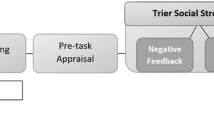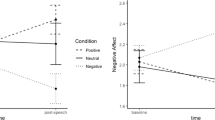Abstract
This study examined the effects of tobacco smoking and cigarette nicotine content on four dimensions of emotional behavior (peripheral autonomic, electrocortical, cognitive, and overt motor) during both the preparation for and the performance of a psychosocially stressful task (extemporaneous speaking). Three groups of experienced smokers either did not smoke, smoked a low-nicotine cigarette, or smoked a high-nicotine cigarette while they were preparing to perform the speaking task. All subjects reported prior to the experiment that they did experience smoking as relaxing and that they did experience a stronger desire to smoke under a variety of negative affective states compared to a variety of positive affective states. In spite of these verbal reports, however, neither the smoking ritual nor the nicotine content of the cigarette smoked had a significant effect on any of the four dimensions of the emotional behavior studied during either the preparation for or the performance of the task. These results were discussed in terms of previous psychophysiological studies utilizing different types of stressors and behavioral indices of emotion.
Similar content being viewed by others
References
Benjamin, L. S. (1967). Facts and artifacts in using analysis of covariance to “undo” the law of initial values.Psychophysiology 4: 187–206.
Eysenck, H. J. (1973). Personality and the maintenance of the smoking habit. In Dunn, W. L. (ed.),Smoking Behavior: Motives and Incentives, V. H. Winston, Washington, D.C.
Friedman, J., Horvath, T., and Mears, R. (1974). Tobacco smoking and a “stimulus barrier.”Nature 248: 455–456.
Gilbert, D. G. (1979). Paradoxical tranquilizing and emotion-reducing effects of nicotine.Psychol. Bull. 86: 643–661.
Gilbert, D. G., and Hagen, R. L. (1980). The effects of nicotine and extraversion on self-report, skin conductance, electromyographic, and heart responses to emotional stimuli.Addict. Behav. 5: 247–257.
Gilman, A. G., Goodman, L. S., and Gilman, A. (1980).Goodman and Gilman's the Pharmacological Basis of Therapeutics, 6th ed., Macmillan, New York.
Heimstra, N. W., Bancroft, N. R., and DeKoch, A. R. (1967). Effects of smoking upon sustained performance in a simulated driving task.Ann. N. Y. Acad. Sci. 142: 295–307.
Hutchinson, R. R., and Emley, G. B. (1973). Effects of nicotine on avoidance, conditioned suppression and aggression response measures in animals and man. In Dunn, W. L. (ed.),Smoking Behaviors: Motives and Incentives, V. H. Winston, Washington, D.C.
Jasper, H. H. (1958). Report of the committee on methods of clinical examination in electroencephalography.Electroencephalogr. Clin. Neurophysiol. 10: 370–375.
Knott, V. J., and Venables, P. H. (1977). EEG alpha correlates of non-smokers, smokers, smoking, and smoking deprivation.Psychophysiology 14: 150–156.
Logue, P. E., Gentry, W. D., Linnoila, M., and Erwin, C. W. (1978). Effect of alcohol consumption on state anxiety changes in male and female nonalcoholics.Am. J. Psychiat. 135: 1079–1081.
Mendelson, J. H., La Dou, J., and Solomon, P. (1964). Experimentally induced chronic intoxication and withdrawal in alcoholics. 3. Psychiatric findings.Q. J. Stud. Alcohol. Suppl. 2: 40–52.
Nathan, P. E., and O'Brien, J. S. (1971). An experimental analysis of the behavior of alcoholics and nonalcoholics during prolonged experimental drinking: A necessary precursor of behavior therapy?Behav. Ther. 2: 455–476.
Nathan, P. E., Titler, N. A., Lowenstein, L. M., Solomon, P., and Rossi, A. M. (1970). Behavioral analysis of chronic alcoholism.Arch. Gen. Psychiat. 22: 419–430.
Nesbitt, P. D. (1973). Smoking, physiological arousal, and emotional response.J. Personal. Soc. Psychol. 25: 137–144.
Paul, G. L. (1966).Insight vs. Desensitization in Psychotherapy, Stanford University Press, Stanford, Calif.
Perlick, D. A. (1977). The withdrawal syndrome: Nicotine addiction and the effects of stopping smoking in heavy and light smokers (doctoral dissertation, Columbia University).Dissert. Abstr. Int. 38: 409-B.
Schacter, S. (1978). Pharmacological and psychological determinants of smoking.Ann. Intern. Med. 88: 104–114.
Silverstein, B. (1982). Cigarette smoking, nicotine addiction and relaxation.J. Personal. Soc. Psychol. 42: 946–950.
Spielberger, C., Gorsuch, R., and Lushene, R. (1970).State-Trait Anxiety Inventory Manual, Consulting Psychologists Press, Palo Alto, Calif.
Author information
Authors and Affiliations
Rights and permissions
About this article
Cite this article
Hatch, J.P., Bierner, S.M. & Fisher, J.G. The effects of smoking and cigarette nicotine content on smokers' preparation and performance of a psychosocially stressful task. J Behav Med 6, 207–216 (1983). https://doi.org/10.1007/BF00845381
Accepted:
Issue Date:
DOI: https://doi.org/10.1007/BF00845381




